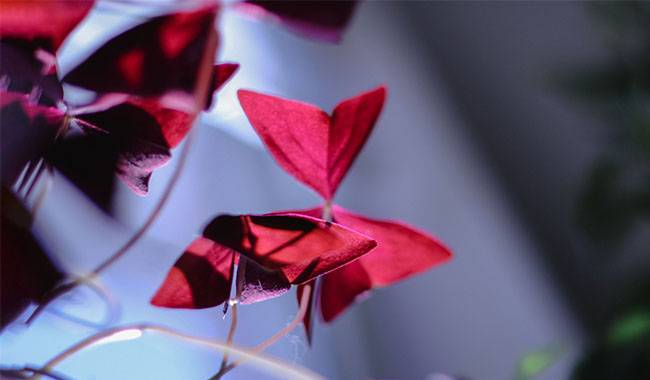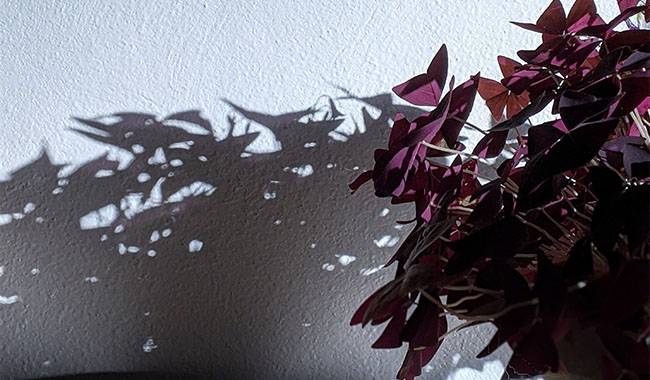
The fascinating Oxalis Triangularis not only blooms all summer but for up to nine months at a time, making it one of the most exquisite, unusual, yet easy to grow plants. Many people consider it almost “indestructible.” However, if you look closely, you will see how sensitive it is to slight changes in conditions and care. Sometimes unexpected difficulties arise. Oxalis Triangularis, either because of a serious lapse or for barely noticeable reasons – may not produce graceful flowers for months or grow “still” with a few butterfly-like leaves. Why Oxalis Triangularis does not bloom will be discussed in ThumbGarden’s article.
HOW LONG DOES OXALIS TRIANGULARIS TAKE TO BLOOM?
Wood sorrel (Oxalis triangularis) is one of the most popular species of indoor cepes, fascinated by the beauty of its cool purple leaves. The bush is large and spreading due to the long petiole. Depending on the variety, the elegant Oxalis triangularis leaves form a white, pink, or lavender background with tubular flowers up to 1 inch (2.5 cm) in diameter. The slender pedicels allow them to spread gracefully between the leaves and respond sensitively to air movement. The species responds quickly to stimuli and changes in light, covering the flowers and folding the leaves.
If everything goes according to plan, Oxalis Triangularis begins its surprisingly long flowering period about a month after transplanting. And it does not always coincide with rapid growth. After gaining strength, flowering can last for 8-9 months, stopping only in winter due to shorter daylight hours.
To ensure spectacular flowering, fast growth, and big colorful mats, Oxalis Triangularis does not even necessarily need a cool overwinter. If the basic requirements of lighting and care are respected, Oxalis Triangularis can indeed provide amazing long-term enjoyment. But that’s not always the case. Even if you follow all the advice, you may end up with an unexpectedly stunted plant instead of a lush beauty. And problems are unpredictable and often not easy to spot.
Captivated by the delicate, responsive beauty of Oxalis Triangularis, you should be prepared for a sensitivity that extends to everything – including small errors in placement, watering, or feeding.
It is one of the most difficult plants to predict and understand. All Plumeria spp. are proud beauties, preferring to live easily and comfortably, growing as if on their own, adapting well without being overly demanding. Without going to extremes, regular care is sometimes on the verge of carelessness in all aspects except watering, which is better suited to Oxalis Triangularis than obsessive attention.
Let’s figure out what causes, and mistakes can lead to problems with Oxalis Triangularis triangularis blooms and how to avoid them.
The first thing worth ruling out is a plant health problem. Infestation by insects – spider mites, scales is rare and threatens Oxalis Triangularis only when it stands next to the affected plant. And here, insecticides will help. However, improper watering, insufficient light, and high temperatures cause more cases of non-flowering.
IGNORING THE LIGHT-DEPENDENT OXALIS TRIANGULARIS
More often than not, Oxalis Triangularis does not bloom because it does not like light. Experimenting, rearranging, and finding the best location with it is easy: the leaves and growth rate will soon signal whether the plant is comfortable or not.
Direct midday sunlight can leave unsightly burns on the plant’s leaves. But while other Oxalis Triangularis prefer sunlight, Oxalis Triangularis grows well in semi-shade, although its color may fade slightly. Not too much shade: If Oxalis Triangularis does not bloom, suspect it is due to insufficient light.
An eastern windowsill is the best guide for location. In the west, the plant has partial shade in the afternoon. It is placed slightly further indoors in the south or has a permanent diffusion screen. On the other hand, plants may suffer from a lack of light in the north.
OXALIS TRIANGULARIS PLANT IS VERY HOT
Oxycoccus triangularis tolerates summer heat well only outdoors. It is best to limit maximum temperatures to 77 °F (25 °C) in indoor cultures. If the plant is exposed to intense heat in a window or on a balcony, it may bloom suddenly, then rapidly flower and dry out, or barely grow at all, sending out a few unsightly leaves.
Watering and general care can compensate for the hot conditions, but it is best to keep the pot in a container so that the soil in the container does not overheat.
- Place it in a lower position so that the leaves are bathed in light, and the pot is protected.
- Move plants to the background or lower only when there is full sun.
- by wrapping the pot with extra protection (such as a piece of light cloth) or placing it in an outside decorative container.
Increasing the humidity of the air – spray as often as possible – will also help Oxalis Triangularis cope with the heat. Just make sure the nozzle on the sprayer is “foggy” and doesn’t leave any coarse droplets on the plants.
A cool overwintering temperature of 50 °F (10°C) minimum is desirable, but not necessary, for Oxalis Triangularis. This species will also bloom if overwintered at temperatures above 68 °F (20 °C). While cooler temperatures will stimulate more vigorous growth and more flowers, the warmth of winter must also be “combined” with care errors to result in no flowering at all.
MISSED OPERATIONS IN CARING FOR OXALIS TRIANGULARIS

Oxalis Triangularis likes to be watered heavily but is afraid of humidity. Overwatering is one of the main causes of all problems. The tubers do not rot as easily, but growth stops quickly. However, watering Oxalis Triangularis as sparsely as the bulbs would also be a big mistake. Even short-term droughts can affect flowering and growth, and you shouldn’t expect much gratitude from the plants even if the substrate dries out for a long time. Except during dormancy: The root system will not die from a few weeks of “dry” watering in winter.
To eliminate the inhibition of flowering by improper watering, you should allow the top 2 inches (5 cm) of soil to dry out from March to late fall and gradually reduce watering through December. Dry the substrate more thoroughly in winter, keeping half of the pot warm and almost completely cold.
Don’t overlook the possibility of using the increased humidity to promote greenery, enhance color and compensate for the heat. Spraying or using a humidifier can stimulate growth and flowering.
Over- or under-fertilization can also lead to under-blooming. Oxalis Triangularis should be fertilized as early as one month after the start of vigorous growth or at transplanting, every 14 to 20 days until the end of August. For Oxalis Triangularis, it is worth choosing a general-purpose fertilizer and half the concentration.
Lack of cleaning and removal of bloomed flowers does not lead to a cessation of flowering but simply indicates a sloppy appearance.
TRAUMATIC TRANSPLANTING OF OXALIS TRIANGULARIS
Fast-growing Oxalis Triangularis is most commonly transplanted annually. Handle tubers gently and try not to divide the plants into tiny groups (less than 10 plants). Remove dry petioles and pedicels when repotting.
Transplant at the beginning of growth or transfer to achieve a different flowering time (first flowers appear after 4-6 weeks). And make sure the drainage layer is no less than 1-2 inches (2.5-5 cm), and the tubers are covered with about 0.4 inches (1 cm) of soil. Planting as deep and shallow as possible will result in non-flowering and growth problems.
Oxalis Triangularis do not flower, but they do not develop properly in heavy soil in the first place. Even a good quality general purpose substrate needs to be improved with additional sand, perlite, or other loosening agents. Ready-made bulb substrates work very well for them.
One of the main causes of Oxalis Triangularis robin’s “misery” is containers with standing water in the bottom that are too deep. The plant is a vigorous grower, needs free space, and can only bloom and grow properly in pots with a diameter greater than its height. And there are always large drainage holes. Oxalis Triangularis prefers ceramic, which protects it better from overheating.
One of the reasons Oxalis Triangularis may not produce leaves or flowers for a long time is improper care after transplanting. A cool place and strict watering are best to ensure quick acclimatization. Feeding, heating, and over-watering are contraindicated.
Additional emphasis can be placed on Oxalis Triangularis plants if the usual measures are inappropriate. Suddenly moving to a cooler or shadier location, severe soil drying, resting outside for a period of time, stopping fertilization – these drastic measures often cause Oxalis Triangularis, which has hardly any foliage, to bloom suddenly and quickly after resuming normal care. Some growers have even tried dropping Oxalis Triangularis.
On the other hand, if the foliage grows normally, but Oxalis Triangularis is not flowering, simple light stress – shading for a few days in as bright a light as possible or lowering the temperature will do the trick.







